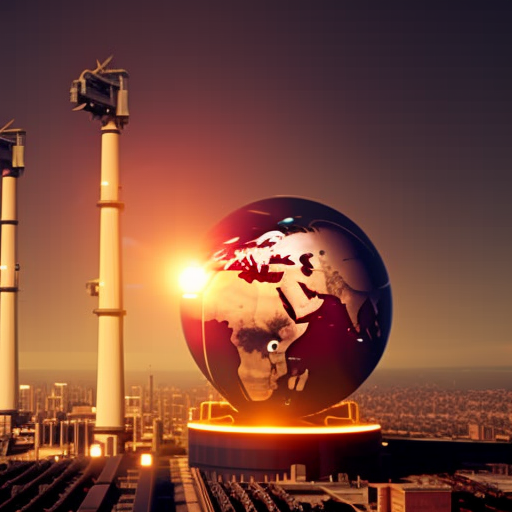
The Global Waste To Energy Market Size
The Global Waste To Energy Market Size is projected to grow from USD 35.52 Billion in 2022 to USD 66.05 Billion By 2032, at a Compound Annual Growth Rate (CAGR) of 6.4% during the forecast period.
Get a Sample PDF Brochure:
Waste-to-Energy (WtE) is a process that converts solid waste into usable energy, such as electricity or heat. It offers an environmentally sustainable solution by reducing waste volume, minimizing greenhouse gas emissions, and decreasing reliance on fossil fuels. Waste is incinerated in specialized facilities, generating heat that is used to produce steam, driving turbines to generate electricity. Advanced technologies ensure efficient energy recovery and stringent emission control. WtE contributes to a circular economy by safely disposing of residual ash. It provides an effective waste management strategy, reducing landfill use and harnessing the energy potential of waste materials.
Browse key industry insights spread across 200 pages with 120 market data tables and figures & charts from the report on, “Global Waste To Energy Market Size, Share, and COVID-19 Impact Analysis, By Technology (Thermochemical and Biochemical), By Waste Type (Municipal Solid Waste, Process Waste, Agriculture Waste, and Others), By Application (Electricity and Heat), By Region (North America, Europe, Asia-Pacific, Latin America, Middle East, and Africa), Analysis and Forecast 2023 – 2032.” Get Detailed Report Here:
Thermochemical segment is expected to grow at a CAGR of around 6.1% during the forecast period.
Based on the technology, the global waste to energy market is segmented into thermochemical and biochemical. The thermochemical segment is expected to experience significant growth in the forecast period in the Waste-to-Energy (WtE) market. Thermochemical processes involve the combustion or gasification of waste materials to generate heat or syngas, which can be further converted into electricity or fuel. This segment’s growth is driven by advancements in technology, such as improved efficiency and emission control, making thermochemical WtE solutions more attractive. Additionally, the ability to handle a wide range of waste types and the increasing demand for renewable energy sources contribute to the anticipated growth of the thermochemical segment in the WtE market.
The electricity segment held the largest market share with more than 65.4% in 2022.
Based on the application, the global waste to energy market is segmented into electricity and heat. The electricity segment holds the largest market share in the Waste-to-Energy market due to the increasing global demand for electricity and the ability of waste-to-energy facilities to generate electricity from waste. WtE technologies, such as incineration and gasification, produce heat that is used to generate steam and drive turbines, producing electricity. The electricity segment’s dominance is driven by the growing emphasis on renewable energy sources and the need to reduce dependence on fossil fuels. Additionally, government incentives and favorable policies promoting renewable energy further contribute to the significant market share of the electricity segment in the WtE market.
Inquire Before Buying This Research Report: Inquire Before Buying
Europe is predicted to grow at a significant CAGR of around 6.7% over the projected period.
Based on region, Europe is expected to experience significant growth in the Waste-to-Energy (WtE) market during the forecast period. The region has been at the forefront of sustainable waste management practices, with stringent regulations and policies promoting the transition towards a circular economy. Europe’s focus on reducing landfilling and increasing renewable energy sources drives the demand for WtE solutions. The presence of well-established infrastructure, advanced technologies, and favorable government support further facilitates market growth. Additionally, increasing awareness and public acceptance of WtE as an environmentally friendly solution contribute to the region’s anticipated growth. Europe’s commitment to sustainable development and energy transition positions it as a promising market for Waste-to-Energy in the coming years.
Competitive Analysis:
The report offers the appropriate analysis of the key organizations/companies involved within the global market along with a comparative evaluation primarily based on their product offering, business overviews, geographic presence, enterprise strategies, segment market share, and SWOT analysis. The report
SDGs, Targets, and Indicators Analysis
1. Which SDGs are addressed or connected to the issues highlighted in the article?
- SDG 7: Affordable and Clean Energy
- SDG 9: Industry, Innovation, and Infrastructure
- SDG 11: Sustainable Cities and Communities
- SDG 12: Responsible Consumption and Production
- SDG 13: Climate Action
- SDG 15: Life on Land
The article discusses the waste-to-energy market, which is directly related to SDG 7 as it focuses on affordable and clean energy. It also mentions the technological advancements in waste-to-energy processes, which align with SDG 9 on industry, innovation, and infrastructure. The article further highlights the environmental benefits of waste-to-energy, such as reducing greenhouse gas emissions and promoting sustainable waste management, which are connected to SDGs 11, 12, 13, and 15.
2. What specific targets under those SDGs can be identified based on the article’s content?
- Target 7.2: Increase substantially the share of renewable energy in the global energy mix.
- Target 9.4: Upgrade infrastructure and retrofit industries to make them sustainable.
- Target 11.6: Reduce the adverse per capita environmental impact of cities.
- Target 12.5: Substantially reduce waste generation through prevention, reduction, recycling, and reuse.
- Target 13.2: Integrate climate change measures into national policies, strategies, and planning.
- Target 15.2: Promote the implementation of sustainable management of all types of forests.
Based on the article’s content, these targets can be identified as relevant to the waste-to-energy market and its environmental and energy-related benefits.
3. Are there any indicators mentioned or implied in the article that can be used to measure progress towards the identified targets?
Yes, the article mentions several indicators that can be used to measure progress towards the identified targets:
- Share of renewable energy in the global energy mix
- Investments in upgrading infrastructure and retrofitting industries
- Reduction in greenhouse gas emissions
- Reduction in waste generation and increase in recycling rates
- Incorporation of climate change measures in national policies and planning
- Improvement in sustainable forest management practices
These indicators can be used to track the progress made in achieving the targets related to waste-to-energy and its environmental and energy-related benefits.
Table: SDGs, Targets, and Indicators
| SDGs | Targets | Indicators |
|---|---|---|
| SDG 7: Affordable and Clean Energy | Target 7.2: Increase substantially the share of renewable energy in the global energy mix. | Share of renewable energy in the global energy mix |
| SDG 9: Industry, Innovation, and Infrastructure | Target 9.4: Upgrade infrastructure and retrofit industries to make them sustainable. | Investments in upgrading infrastructure and retrofitting industries |
| Target 9.5: Enhance scientific research, upgrade the technological capabilities of industrial sectors, and encourage innovation. | Advancements in waste-to-energy technology | |
| SDG 11: Sustainable Cities and Communities | Target 11.6: Reduce the adverse per capita environmental impact of cities. | Reduction in greenhouse gas emissions |
| SDG 12: Responsible Consumption and Production | Target 12.4: Achieve environmentally sound management of chemicals and all wastes throughout their life cycle. | Reduction in waste generation and increase in recycling rates |
| Target 12.5: Substantially reduce waste generation through prevention, reduction, recycling, and reuse. | Reduction in waste generation and increase in recycling rates | |
| SDG 13: Climate Action | Target 13.2: Integrate climate change measures into national policies, strategies, and planning. | Incorporation of climate change measures in national policies and planning |
| SDG 15: Life on Land | Target 15.2: Promote the implementation of sustainable management of all types of forests. | Improvement in sustainable forest management practices |
Behold! This splendid article springs forth from the wellspring of knowledge, shaped by a wondrous proprietary AI technology that delved into a vast ocean of data, illuminating the path towards the Sustainable Development Goals. Remember that all rights are reserved by SDG Investors LLC, empowering us to champion progress together.
Source: globenewswire.com

Join us, as fellow seekers of change, on a transformative journey at https://sdgtalks.ai/welcome, where you can become a member and actively contribute to shaping a brighter future.






